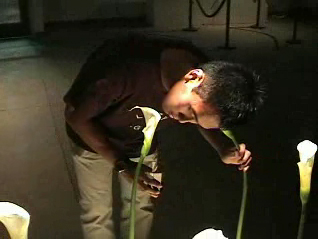Human Flower Project
Monday, March 31, 2008
Why Callas Must Moan: Jay Yan
With callas that sigh, a California artist combines digital media and fresh flowers with his art world savvy to entice an international audience.

A gallery goer bends down to attend Jay Yan’s Whisper
Photo: Jay Yan
A few fundamentals. Flowers contain the sex organs of plants—it’s true. And yes, art is a form of exhibitionism.
A delightful young artist from Los Angeles, Jiacong (Jay) Yan, has turned these basics into interactive works designed to allure and startle. In these times, artists who allure only tend to be dismissed as frivolous. (A shame, we say. How many Watteaus have turned to truck driving?)
What drew us to Jay were the flowers in his piece Whisper. In a dark room, nine white calla lilies stand illuminated from above, and as you approach them, you hear each flower moaning tenderly. If there’s an auditory equivalent of “voyeurism,” here it is, sighing in a public gallery. Since it’s just flowers, not a writhing woman, listening is socially acceptable, sort of; but calling it “art” is the real kiss of guilt-freedom.
Jay, born 1983 in Shanghai, moved to the U.S. in 1990 and now lives in Los Angeles. “I am born Chinese, raised American, and now because Chinese art is so hot, Chinese once more,” he states in an online bio. We enjoy how Jay both plays along with many rules of the art world and breaks the big one—disclosing that there ARE rules everyone plays by. He very generously wrote to us about the evolution of Whisper, an intriguing story, we think, as it illustrates some of the pressures—social, conceptual, financial, political—that are molding contemporary artists and what they make.
 Jay Yan
Jay Yan
“Whisper came to me when I was kicking a ball around with a friend. Like anything worth making, it came inexplicably,” Jay writes. “I said to myself, ‘If flowers could talk, what would they say?’ We explored romantic notions, agricultural notions, environmental complaints, and then realized, ‘Wait, all these notions are placed on flowers by society.’ Like my professor Jennifer Steinkamp once said, ‘Flowers are innocent. Flowers do not represent love, charity, sorrow, friendship —if society was not around. What do flowers do if we really abstract it enough?’ Well, that’s obvious, right? sex.”
All the classroom philosophizing, considerations of social constructedness and the like, land back at square one. Nonetheless, most “serious” contemporary artists feel obligated to engage in such a conceptual workout.
Back to Jay: “Again, idea of sex and flowers—not new. Georgia O’Keefe explored it extensively through her paintings, and Robert Mapplethorpe did through his photography. I wanted to reference both in Whisper. (Also, I found a company in Japan that makes flowers talk! Too bad they’re out of business now, haha. The talking flower didn’t prove to be that popular; I think I was their only customer).” We wrote a bit about that product, Jay, right here. Good to hear from one person—as you say, maybe the only one—who bought it.
He goes on: “So the piece consists of 9 flowers, each of them calla lilies. Calla lilies being not only the best flower for talking but also Georgia O’Keefe and Mapplethorpe both used it extensively in their works. The sexualization of calla lilies is quite explored in art history. I included a very strong spot light from above the piece to give it the shadows Mapplethorpe uses so well.”
Exploring the precedents for his subject, Jay fulfills another another artistic obligation. The point is not to imitate what’s come before but to advance past it somehow—either slaying your forebears or, more benignly, standing on their shoulders. Noting that many an art historian has written about human sexuality and callas, Jay mentions only art celebrities of the recent past—O’Keefe and Mapplethorpe— maybe because their popularity serves as a kind of cultural shorthand.

Jay Yan’s Whisper during its exhibition in Shanghai
Callas must not have been available; these look like Easter lilies (Lilium longiflorum)
Photo: Jay Yan
“The flowers each moan softly like during intimacy, and it’s a female voice,” Jay writes. “I know, sounds very sexist. Let me tell you another story….
“So at first, I had each flower whisper prepared text by my friends who all gave me their favorite lines they like to whisper to someone’s ear during intimacy. Then I recorded both male and female voice actor tracks. Oh boy, was that hard. First off, I auditioned 120 people. Here is one typical result from an actor:
“The funny part was, his girlfriend was next to him, so I gave her a quick glance like, ‘Does he talk to you like this normally?’
“Then I got criticized by a curator at the Getty about the choice of words (well ‘criticized’ is a strong word— more like, he was interested in buying it, then he asked about the text, and when I told him, he stopped becoming interested). This coupled with each flower having a different voice proved not that interesting after a while, and the electronics for making each flower having a different voice becoming expensive and hard to find. I decided they should all be the same.” Maybe if a few gladioli, pansies and snapdragons had been mixed in, different “texts” would have been warranted.
But, Jay, how rare it is for artists to admit that the wrinkled nose of a museum official or gallery owner or some other arbiter changed their creative course! As heliotropic flowers turn their faces to the sun, artists intent on growing their careers do heed the responses of authorities. It happens all the time! And of course there are feasibilities to consider. Media artists can dream beyond their technical capacities, and their finances. Let’s be real.
“The reduction of audible words to a moan came about because Art is international these days. Hell, 100% of all my shows are all overseas in non-English speaking countries. How can they understand the sexualities of the piece if they don’t speak English? So to the dismay of many of my female friends, but support of all my female friends that make art (funny how making art changed your opinions) I auditioned for moans.”
What used to be called art’s “universality” is now a feature of art world globalism. And Jay neatly avoided what might have been a linguistic barrier, by nixing words.

Listening with happiness to Whisper
Photo: Jay Yan
“That was another 60 horrible auditions. But I finally came up with one that was great. I liked her because just listening to her can invoke the feeling of eroticism instantly in any language. I like the idea of people at an art museum or gallery in public and putting their ear to the piece and hearing it and getting turned on because it’s such a socially inappropriate thing, thus taboo. And taboo is the basis of eroticism (so it’s like a loop!).” See above.
Though Whisper’s blooms and sighs both travel easily across international boundaries, Jay points out how variously the piece has been received.
“In China, since sex in art is taboo enough to get you banned, I had a show and when the censors came to inspect the show, I unplugged the work so they just thought it was a nice looking sculpture. During the opening, a famous curator commented that he was amazed I got away with such a piece in China. The censors came back the next day apparently, but I think a janitor accidentally unplugged the piece! haha.
“In Asia, men love the piece. Many women like it, but are apprehensive about it. I suspect it could be like a Confucius thing (like how it is only appropriate for Chinese women to associate with men in church). This might be a bias, but it’s my observation from hanging around Chinese churches at a young age. Sex is still soooooo taboo in China.
“The opposite is found in, say, Europe where women all love the piece. They openly tell me and some have offered me drugs because they appreciated the experience with the piece so much.” Not exactly “fame, money, and beautiful lovers,” but, hey, there’s a recession going on.
“As opposed to men in Europe, who are very restrained about their contact with the piece. An observer said to me at a show, ‘The piece is so sensual, it’s surprising a man made it.’ I think this is the interesting part, I think the sensuality turns men off in Europe because they might fear losing their manhood in public by being near the piece. They loved the giant robot hand that was next to my piece!
“Oh, and Germans generally dislike the piece. I still haven’t figured out why.” General Germans, please let us hear from you.
Congratulations and nine breathy thanks to Jay for his account of a provocative Human Flower Project, its creation and reception. In case you don’t have the opportunity to see and hear Whisper in person, Jay has supplied a video on his website.




